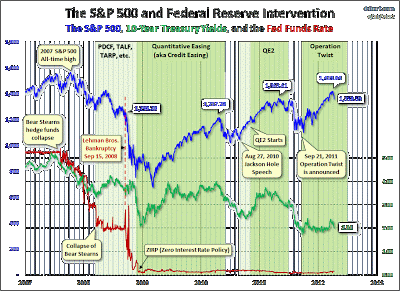
 Gas prices are not high. The currency you use to pay for gas is losing value. This requires more of that currency to purchase the exact same product it purchased earlier before it lost value. Products like gas.
Gas prices are not high. The currency you use to pay for gas is losing value. This requires more of that currency to purchase the exact same product it purchased earlier before it lost value. Products like gas.
Click on any chart to make it bigger
When you hear "gas prices are rising" I hear "your dollar is falling!" Central banks keep printing money (they call it bond-buying or quantitative easing but it's printing) to manipulate the stock market higher / keep it from falling to maintain the illusion of a "recovery". The increase in the number of dollars decreases the value of existing dollars. It's as simple as that.

Imagine your Monopoly board as a kid, only your friend brings over the bank from his set too. Now you've got twice the Monopoly money to chase the same Monopoly real estate. Double how much monopoly money you start the game with as well. Every time someone lands on a property instead of buying it you have to give every one a chance to bid on it. You can watch the housing bubble in the comfort of your own board game! The board is exactly the same, but because you doubled the supply of money available to everyone to bid on it the price goes up. Now, imagine the banker of your game gets the bright idea to give all the players MORE money! Triple. Quadruple. Doesn't matter does it? The property has the same value as before you increased your bank...it's just your paper monopoly money is worth LESS because you added more of it. Money is simply a store of value, and is inherently worthless (it's paper!). Here's a couple charts from our Monopoly bankers, the Federal Reserve, to illustrate.
 |
| CONSUMER PRICES WITH NO ITEMS EXCLUDED |
 |
| Dude...they're like...IDENTICAL! |
 |
| MONEY SUPPLY |
 |
| Print, and Ye Shall Rise! |
 |
| this is called a "Direct Correlation" |
Here are some recent headlines highlighting stock market action, central banker responses to that action, and the resulting impact on your money at the grocery store, gas pump and everywhere else.
(BLOOMBERG) APRIL 10 2012
DOW FALLS 213 POINTS IN 5TH STRAIGHT DOWN DAY. SP-500 CLOSES UNDER IT'S 50-DAY MOVING AVERAGE FOR THE FIRST TIME IN FOUR MONTHS.
(BLOOMBERG) APRIL 11 2012
Oil climbed from an eight-week low in New York as a European Central Bank official signaled the lender may act to stem the spread of the region’s debt crisis.
Futures rose as much as 0.7 percent and the euro gained against the dollar after ECB Executive Board member Benoit Coeure suggested that the bank may restart bond purchases for Spain. U.S. supplies increased by 6.58 million barrels last week, the American Petroleum Institute said yesterday. The Energy Department will report on stockpiles today.
“The dollar came under pressure and oil rose after an ECB official hinted that the bank may purchase Spanish bonds,” said Gene McGillian, an analyst and broker at Tradition Energy in Stamford, Connecticut. “I’m surprised we’re up at all after the pretty bearish numbers last night. If the government data confirms the supply build, we’ll probably head for new lows.”
Well, unfortunately for us Main-Streeters Gene, gasoline prices have a lot more to do with Central Bankers printing money than with supply and demand.
 |
| Gasoline demand down sharply since 2008 |
(Reuters) - "The disappointing performance of the U.S. labor market in March shows it is too early to conclude the economy is out of the woods." An influential voting member of the U.S. central bank's monetary policy committee, Dudley appeared to leave the door open to additional stimulus measures.
Federal Reserve Vice Chairman Janet Yellen, 65, also said she’s not concerned that additional asset purchases would leave the Fed unable to control inflation when necessary. The Fed has bought $2.3 trillion of bonds in two rounds of large-scale asset purchases in a bid to reduce long-term borrowing costs and boost the recovery. “I feel fully confident that, regardless of the size of our balance sheet,” the “Fed has the tools, and has thought through carefully how to use the tools, to exit,” she said.
(Bloomberg) 4/12/2012
U.S. Stocks Post Biggest 2-Day Gain in ’12 on Fed Signals
Dow up 250 points since 4/10/2012
Dow up 250 points since 4/10/2012
Commodity, financial and technology shares had the biggest gains in the S&P 500 . “We’ll continue to see similar language: the Fed is ready to provide more accommodation if necessary,” said Russ Koesterich, the San Francisco-based global chief investment strategist for the IShares unit of BlackRock Inc. His firm oversees $3.51 trillion as the world’s largest asset manager.“Yet I wouldn’t expect a definitive sign in April that there’s another round of quantitative easing coming. It’s just the idea that the Fed has that in their back pocket.” Equities rose after Federal Reserve Vice Chairman Janet Yellen and New York Fed President William C. Dudley endorsed the central bank’s view that borrowing costs are likely to stay low through 2014. U.S. central bankers next meet on April 24-25 to debate policy after
http://www.bloomberg.com/news/2012-04-12/u-s-stock-index-futures-climb-as-fed-indicates-low-rates.html
http://money.cnn.com//2012/06/03/investing/stocks-lookahead/index.htm?section=money_markets&utm_source=feedburner&utm_medium=feed&utm_campaign=Feed%3A+rss%2Fmoney_markets+%28Markets%29
http://www.bloomberg.com/news/2012-04-11/yellen-says-jobs-outlook-warrants-accommodative-policy.html
http://www.reuters.com/article/2012/04/12/us-usa-fed-dudley-idUSBRE83B0JN20120412?feedType=RSS&feedName=businessNews&utm_source=feedburner&utm_medium=feed&utm_campaign=Feed%3A+reuters%2FbusinessNews+%28News+%2F+US+%2F+Business+News%29
http://www.bloomberg.com/news/2012-04-11/oil-rises-from-eight-week-low-as-ecb-signals-spanish-aid.html








